instrument cluster BMW 550I XDRIVE 2013 Owner's Manual
[x] Cancel search | Manufacturer: BMW, Model Year: 2013, Model line: 550I XDRIVE, Model: BMW 550I XDRIVE 2013Pages: 246, PDF Size: 5.39 MB
Page 100 of 246
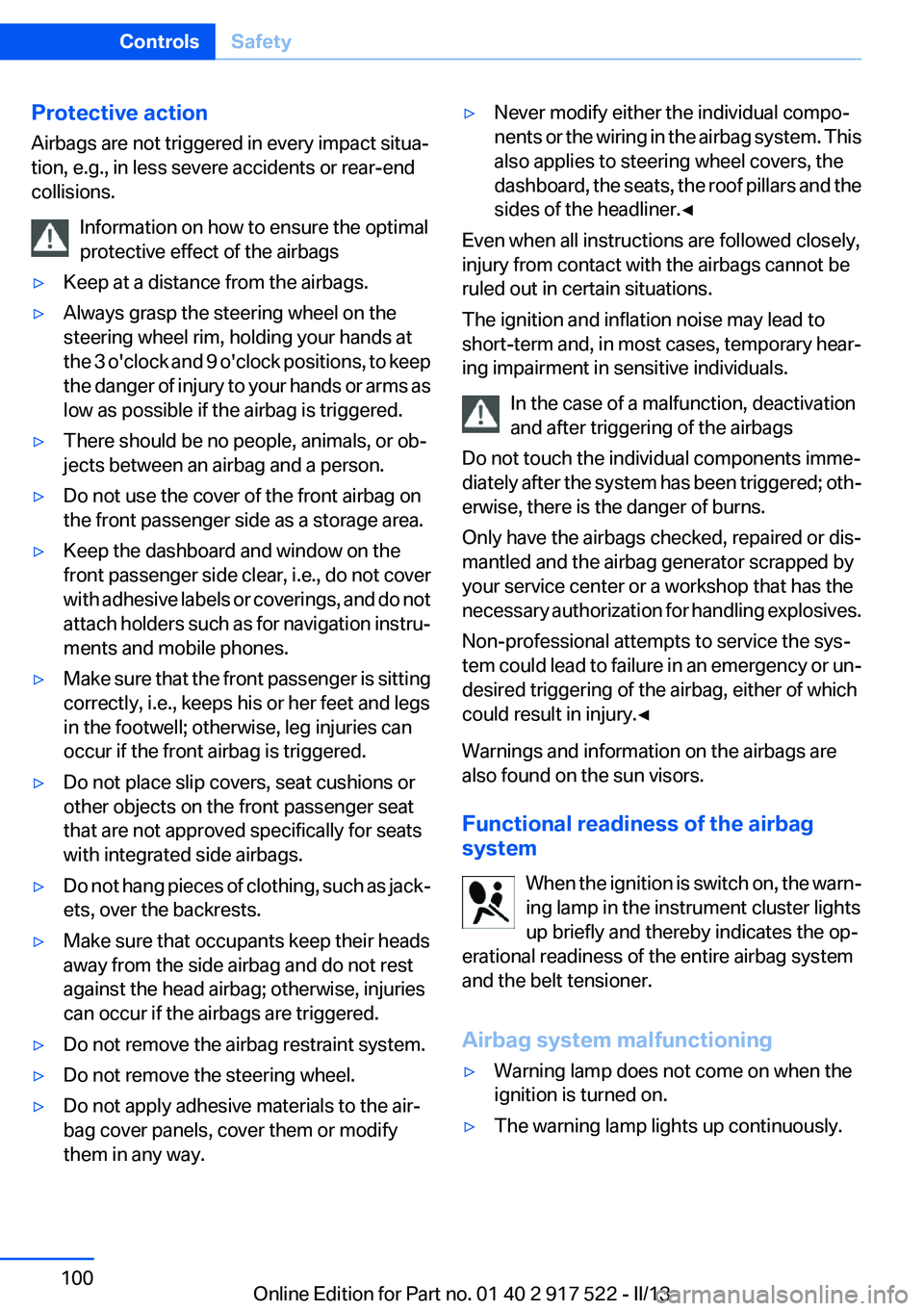
Protective action
Airbags are not triggered in every impact situa‚Äź
tion, e.g., in less severe accidents or rear-end
collisions.
Information on how to ensure the optimal
protective effect of the airbags‚Ė∑Keep at a distance from the airbags.‚Ė∑Always grasp the steering wheel on the
steering wheel rim, holding your hands at
the 3 o'clock and 9 o'clock positions, to keep
the danger of injury to your hands or arms as
low as possible if the airbag is triggered.‚Ė∑There should be no people, animals, or ob‚Äź
jects between an airbag and a person.‚Ė∑Do not use the cover of the front airbag on
the front passenger side as a storage area.‚Ė∑Keep the dashboard and window on the
front passenger side clear, i.e., do not cover
with adhesive labels or coverings, and do not
attach holders such as for navigation instru‚Äź
ments and mobile phones.‚Ė∑Make sure that the front passenger is sitting
correctly, i.e., keeps his or her feet and legs
in the footwell; otherwise, leg injuries can
occur if the front airbag is triggered.‚Ė∑Do not place slip covers, seat cushions or
other objects on the front passenger seat
that are not approved specifically for seats
with integrated side airbags.‚Ė∑Do not hang pieces of clothing, such as jack‚Äź
ets, over the backrests.‚Ė∑Make sure that occupants keep their heads
away from the side airbag and do not rest
against the head airbag; otherwise, injuries
can occur if the airbags are triggered.‚Ė∑Do not remove the airbag restraint system.‚Ė∑Do not remove the steering wheel.‚Ė∑Do not apply adhesive materials to the air‚Äź
bag cover panels, cover them or modify
them in any way.‚Ė∑Never modify either the individual compo‚Äź
nents or the wiring in the airbag system. This
also applies to steering wheel covers, the
dashboard, the seats, the roof pillars and the
sides of the headliner.‚óÄ
Even when all instructions are followed closely,
injury from contact with the airbags cannot be
ruled out in certain situations.
The ignition and inflation noise may lead to
short-term and, in most cases, temporary hear‚Äź
ing impairment in sensitive individuals.
In the case of a malfunction, deactivation
and after triggering of the airbags
Do not touch the individual components imme‚Äź
diately after the system has been triggered; oth‚Äź
erwise, there is the danger of burns.
Only have the airbags checked, repaired or dis‚Äź
mantled and the airbag generator scrapped by
your service center or a workshop that has the
necessary authorization for handling explosives.
Non-professional attempts to service the sys‚Äź
tem could lead to failure in an emergency or un‚Äź
desired triggering of the airbag, either of which
could result in injury.‚óÄ
Warnings and information on the airbags are
also found on the sun visors.
Functional readiness of the airbag
system
When the ignition is switch on, the warn‚Äź
ing lamp in the instrument cluster lights
up briefly and thereby indicates the op‚Äź
erational readiness of the entire airbag system
and the belt tensioner.
Airbag system malfunctioning
‚Ė∑Warning lamp does not come on when the
ignition is turned on.‚Ė∑The warning lamp lights up continuously.Seite 100ControlsSafety100
Online Edition for Part no. 01 40 2 917 522 - II/13
Page 108 of 246
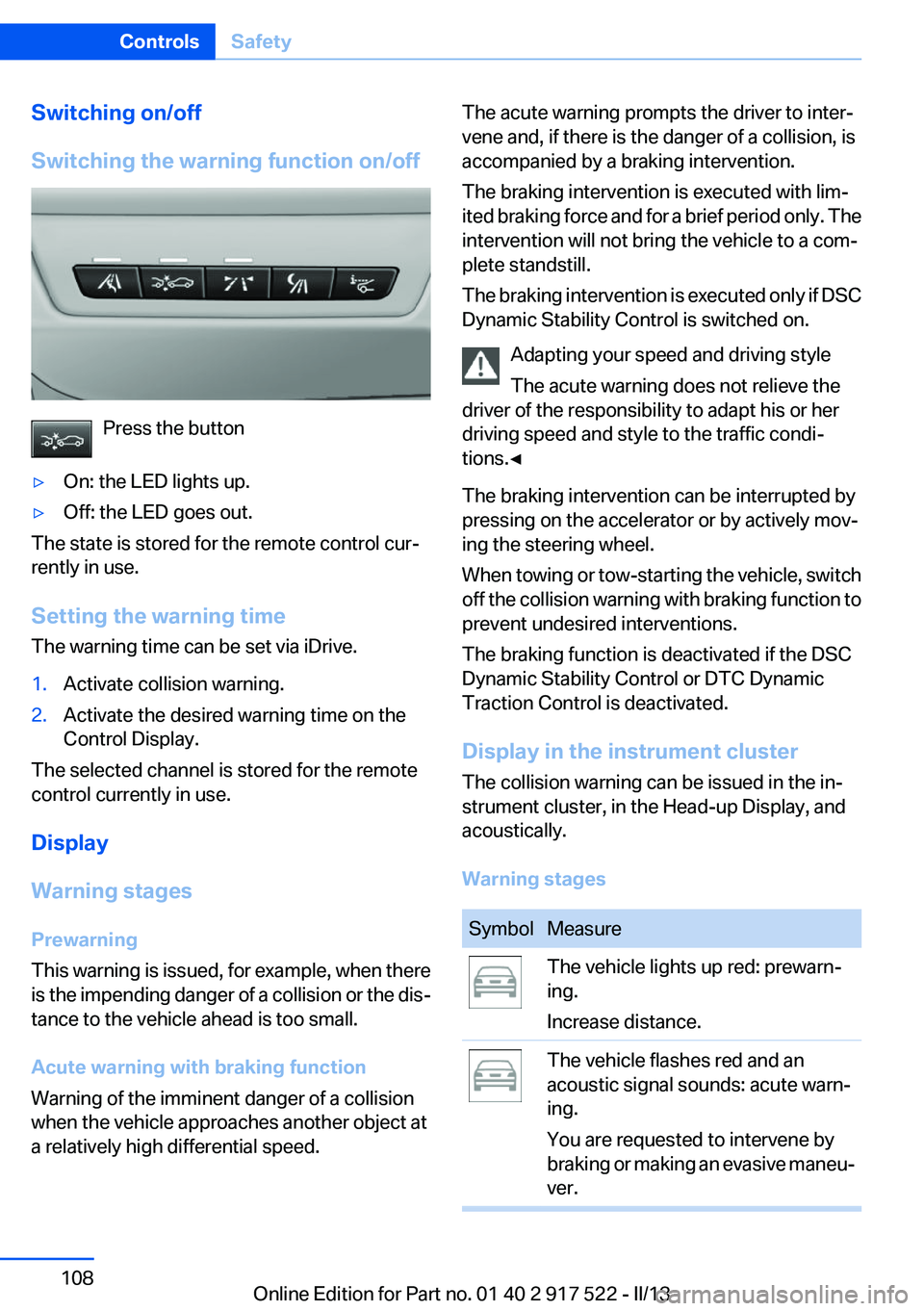
Switching on/off
Switching the warning function on/off
Press the button
‚Ė∑On: the LED lights up.‚Ė∑Off: the LED goes out.
The state is stored for the remote control cur‚Äź
rently in use.
Setting the warning time
The warning time can be set via iDrive.
1.Activate collision warning.2.Activate the desired warning time on the
Control Display.
The selected channel is stored for the remote
control currently in use.
Display
Warning stages
Prewarning
This warning is issued, for example, when there
is the impending danger of a collision or the dis‚Äź
tance to the vehicle ahead is too small.
Acute warning with braking function
Warning of the imminent danger of a collision
when the vehicle approaches another object at
a relatively high differential speed.
The acute warning prompts the driver to inter‚Äź
vene and, if there is the danger of a collision, is
accompanied by a braking intervention.
The braking intervention is executed with lim‚Äź
ited braking force and for a brief period only. The
intervention will not bring the vehicle to a com‚Äź
plete standstill.
The braking intervention is executed only if DSC
Dynamic Stability Control is switched on.
Adapting your speed and driving style
The acute warning does not relieve the
driver of the responsibility to adapt his or her
driving speed and style to the traffic condi‚Äź
tions.‚óÄ
The braking intervention can be interrupted by
pressing on the accelerator or by actively mov‚Äź
ing the steering wheel.
When towing or tow-starting the vehicle, switch
off the collision warning with braking function to
prevent undesired interventions.
The braking function is deactivated if the DSC
Dynamic Stability Control or DTC Dynamic
Traction Control is deactivated.
Display in the instrument cluster
The collision warning can be issued in the in‚Äź
strument cluster, in the Head-up Display, and
acoustically.
Warning stagesSymbolMeasureThe vehicle lights up red: prewarn‚Äź
ing.
Increase distance.The vehicle flashes red and an
acoustic signal sounds: acute warn‚Äź
ing.
You are requested to intervene by
braking or making an evasive maneu‚Äź
ver.Seite 108ControlsSafety108
Online Edition for Part no. 01 40 2 917 522 - II/13
Page 110 of 246
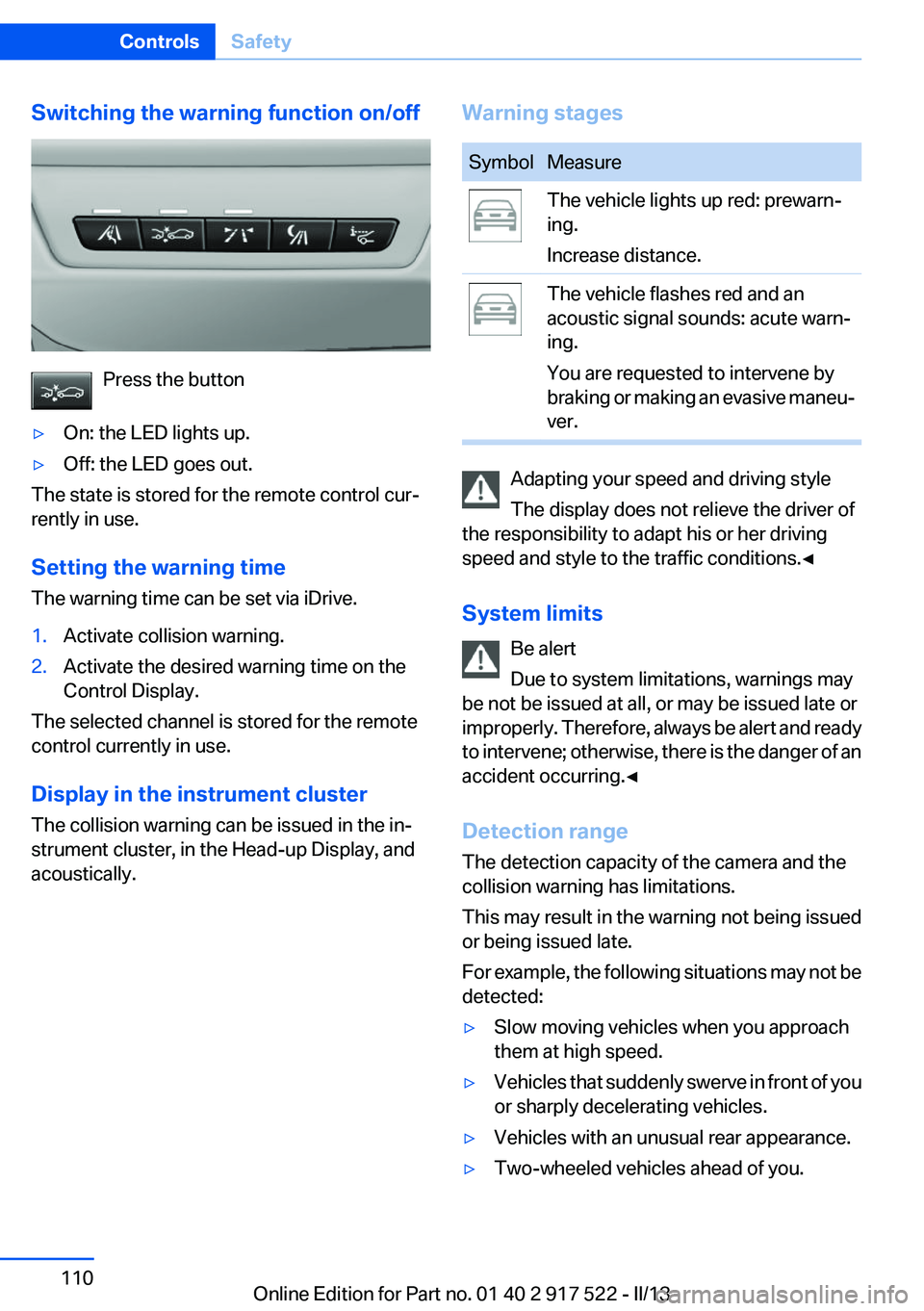
Switching the warning function on/off
Press the button
‚Ė∑On: the LED lights up.‚Ė∑Off: the LED goes out.
The state is stored for the remote control cur‚Äź
rently in use.
Setting the warning time
The warning time can be set via iDrive.
1.Activate collision warning.2.Activate the desired warning time on the
Control Display.
The selected channel is stored for the remote
control currently in use.
Display in the instrument cluster
The collision warning can be issued in the in‚Äź
strument cluster, in the Head-up Display, and
acoustically.
Warning stagesSymbolMeasureThe vehicle lights up red: prewarn‚Äź
ing.
Increase distance.The vehicle flashes red and an
acoustic signal sounds: acute warn‚Äź
ing.
You are requested to intervene by
braking or making an evasive maneu‚Äź
ver.
Adapting your speed and driving style
The display does not relieve the driver of
the responsibility to adapt his or her driving
speed and style to the traffic conditions.‚óÄ
System limits Be alert
Due to system limitations, warnings may
be not be issued at all, or may be issued late or
improperly. Therefore, always be alert and ready
to intervene; otherwise, there is the danger of an
accident occurring.‚óÄ
Detection range
The detection capacity of the camera and the
collision warning has limitations.
This may result in the warning not being issued
or being issued late.
For example, the following situations may not be
detected:
‚Ė∑Slow moving vehicles when you approach
them at high speed.‚Ė∑Vehicles that suddenly swerve in front of you
or sharply decelerating vehicles.‚Ė∑Vehicles with an unusual rear appearance.‚Ė∑Two-wheeled vehicles ahead of you.Seite 110ControlsSafety110
Online Edition for Part no. 01 40 2 917 522 - II/13
Page 115 of 246
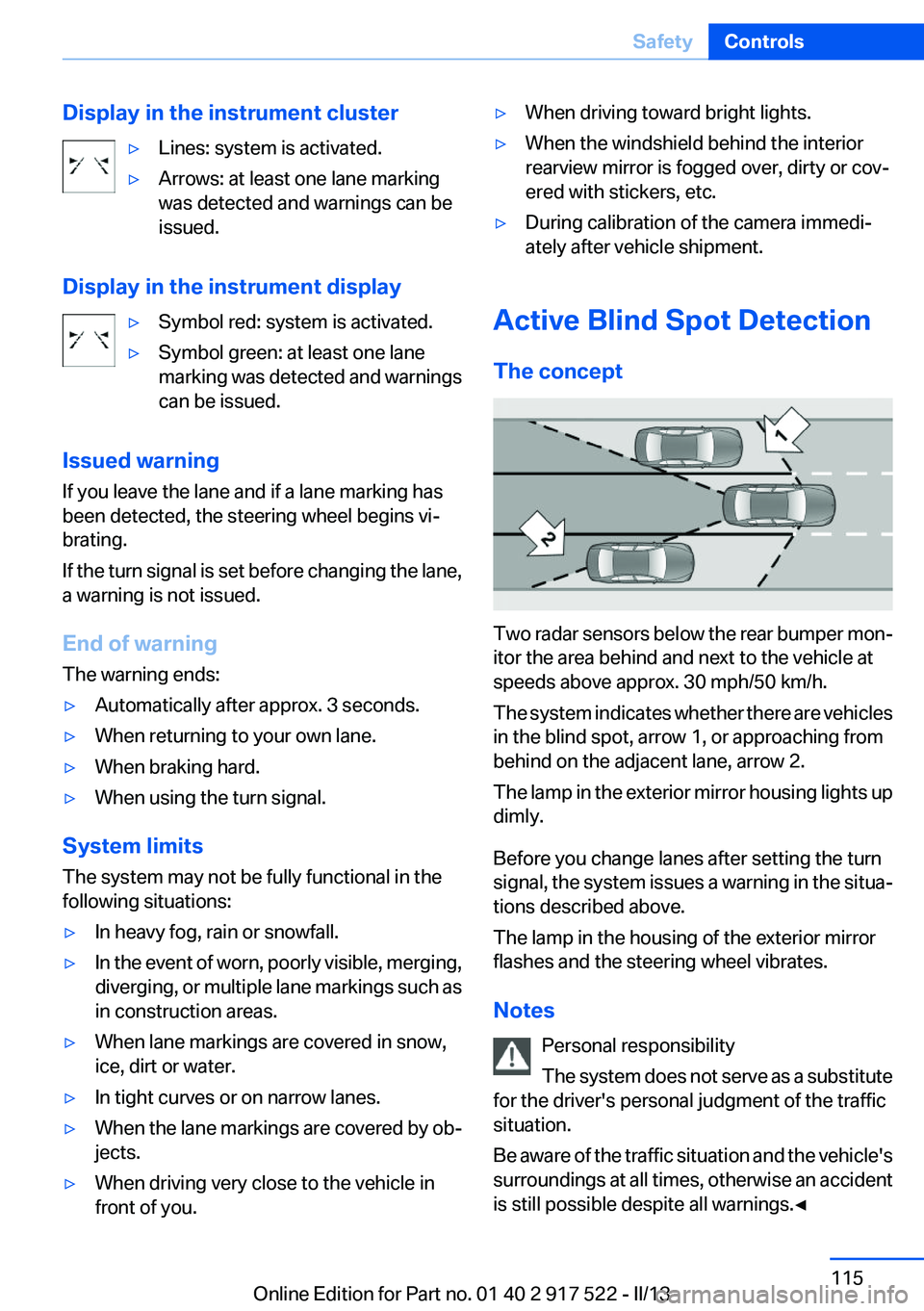
Display in the instrument cluster‚Ė∑Lines: system is activated.‚Ė∑Arrows: at least one lane marking
was detected and warnings can be
issued.
Display in the instrument display
‚Ė∑Symbol red: system is activated.‚Ė∑Symbol green: at least one lane
marking was detected and warnings
can be issued.
Issued warning
If you leave the lane and if a lane marking has
been detected, the steering wheel begins vi‚Äź
brating.
If the turn signal is set before changing the lane,
a warning is not issued.
End of warning
The warning ends:
‚Ė∑Automatically after approx. 3 seconds.‚Ė∑When returning to your own lane.‚Ė∑When braking hard.‚Ė∑When using the turn signal.
System limits
The system may not be fully functional in the
following situations:
‚Ė∑In heavy fog, rain or snowfall.‚Ė∑In the event of worn, poorly visible, merging,
diverging, or multiple lane markings such as
in construction areas.‚Ė∑When lane markings are covered in snow,
ice, dirt or water.‚Ė∑In tight curves or on narrow lanes.‚Ė∑When the lane markings are covered by ob‚Äź
jects.‚Ė∑When driving very close to the vehicle in
front of you.‚Ė∑When driving toward bright lights.‚Ė∑When the windshield behind the interior
rearview mirror is fogged over, dirty or cov‚Äź
ered with stickers, etc.‚Ė∑During calibration of the camera immedi‚Äź
ately after vehicle shipment.
Active Blind Spot Detection
The concept
Two radar sensors below the rear bumper mon‚Äź
itor the area behind and next to the vehicle at
speeds above approx. 30 mph/50 km/h.
The system indicates whether there are vehicles
in the blind spot, arrow 1, or approaching from
behind on the adjacent lane, arrow 2.
The lamp in the exterior mirror housing lights up
dimly.
Before you change lanes after setting the turn
signal, the system issues a warning in the situa‚Äź
tions described above.
The lamp in the housing of the exterior mirror
flashes and the steering wheel vibrates.
Notes Personal responsibility
The system does not serve as a substitute
for the driver's personal judgment of the traffic
situation.
Be aware of the traffic situation and the vehicle's
surroundings at all times, otherwise an accident
is still possible despite all warnings.‚óÄ
Seite 115SafetyControls115
Online Edition for Part no. 01 40 2 917 522 - II/13
Page 120 of 246
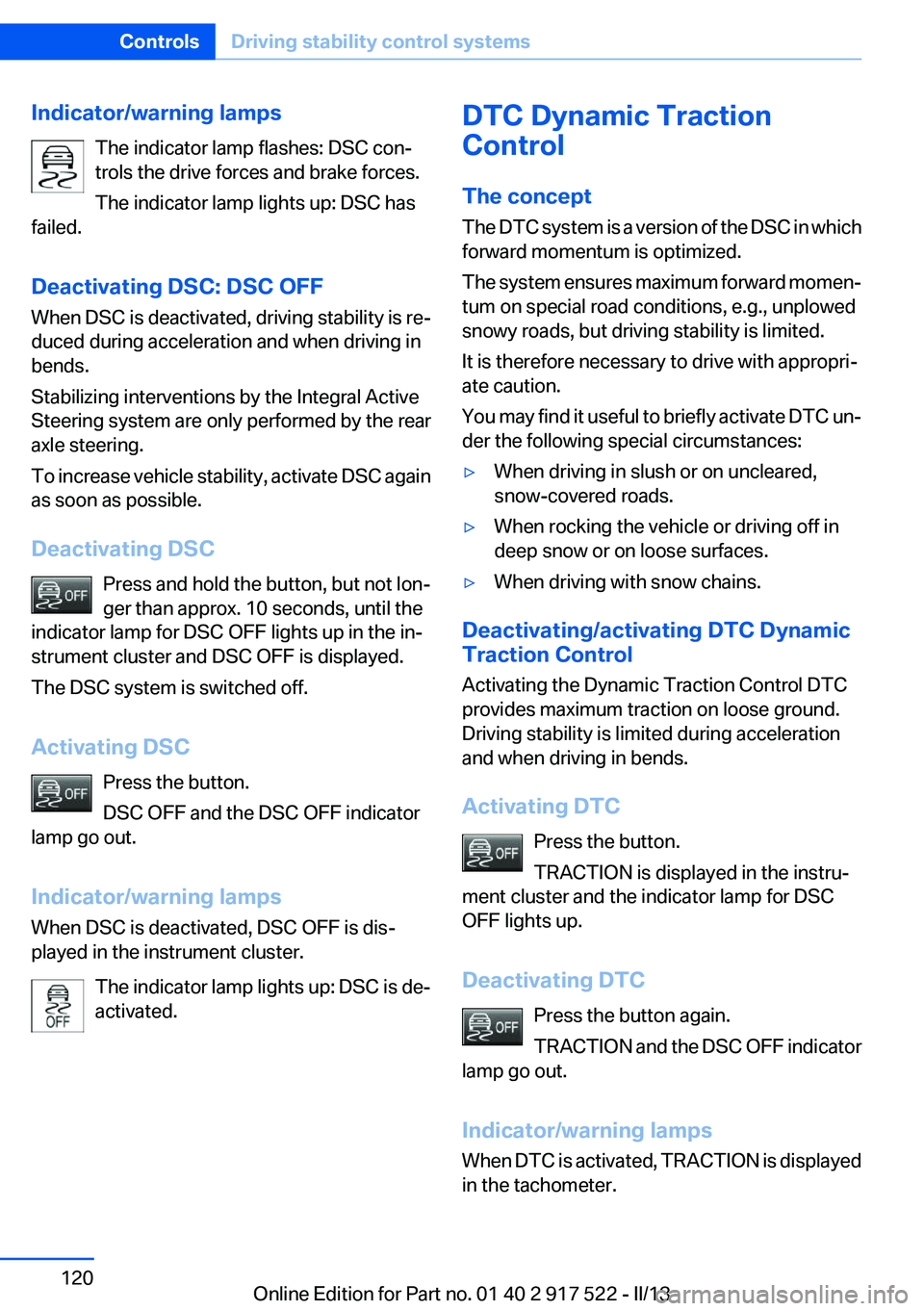
Indicator/warning lampsThe indicator lamp flashes: DSC con‚Äź
trols the drive forces and brake forces.
The indicator lamp lights up: DSC has
failed.
Deactivating DSC: DSC OFF
When DSC is deactivated, driving stability is re‚Äź
duced during acceleration and when driving in
bends.
Stabilizing interventions by the Integral Active
Steering system are only performed by the rear
axle steering.
To increase vehicle stability, activate DSC again
as soon as possible.
Deactivating DSC Press and hold the button, but not lon‚Äź
ger than approx. 10 seconds, until the
indicator lamp for DSC OFF lights up in the in‚Äź
strument cluster and DSC OFF is displayed.
The DSC system is switched off.
Activating DSC Press the button.
DSC OFF and the DSC OFF indicator
lamp go out.
Indicator/warning lamps
When DSC is deactivated, DSC OFF is dis‚Äź
played in the instrument cluster.
The indicator lamp lights up: DSC is de‚Äź
activated.DTC Dynamic Traction
Control
The concept
The DTC system is a version of the DSC in which
forward momentum is optimized.
The system ensures maximum forward momen‚Äź
tum on special road conditions, e.g., unplowed
snowy roads, but driving stability is limited.
It is therefore necessary to drive with appropri‚Äź
ate caution.
You may find it useful to briefly activate DTC un‚Äź
der the following special circumstances:‚Ė∑When driving in slush or on uncleared,
snow-covered roads.‚Ė∑When rocking the vehicle or driving off in
deep snow or on loose surfaces.‚Ė∑When driving with snow chains.
Deactivating/activating DTC Dynamic
Traction Control
Activating the Dynamic Traction Control DTC
provides maximum traction on loose ground.
Driving stability is limited during acceleration
and when driving in bends.
Activating DTC Press the button.
TRACTION is displayed in the instru‚Äź
ment cluster and the indicator lamp for DSC
OFF lights up.
Deactivating DTC Press the button again.
TRACTION and the DSC OFF indicator
lamp go out.
Indicator/warning lamps
When DTC is activated, TRACTION is displayed
in the tachometer.
Seite 120ControlsDriving stability control systems120
Online Edition for Part no. 01 40 2 917 522 - II/13
Page 122 of 246
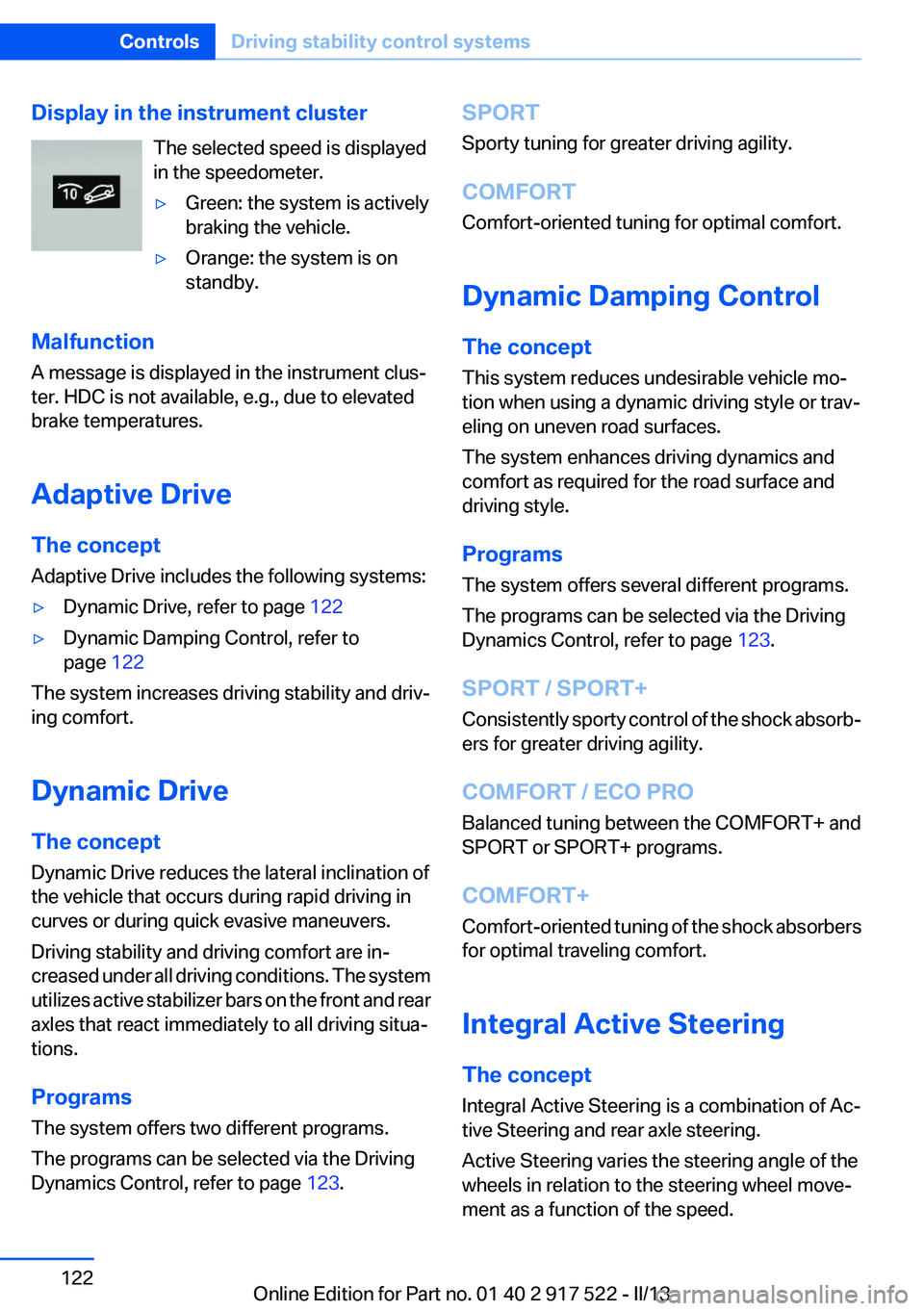
Display in the instrument clusterThe selected speed is displayed
in the speedometer.‚Ė∑Green: the system is actively
braking the vehicle.‚Ė∑Orange: the system is on
standby.
Malfunction
A message is displayed in the instrument clus‚Äź
ter. HDC is not available, e.g., due to elevated
brake temperatures.
Adaptive Drive
The concept
Adaptive Drive includes the following systems:
‚Ė∑Dynamic Drive, refer to page 122‚Ė∑Dynamic Damping Control, refer to
page 122
The system increases driving stability and driv‚Äź
ing comfort.
Dynamic Drive
The concept
Dynamic Drive reduces the lateral inclination of
the vehicle that occurs during rapid driving in
curves or during quick evasive maneuvers.
Driving stability and driving comfort are in‚Äź
creased under all driving conditions. The system
utilizes active stabilizer bars on the front and rear
axles that react immediately to all driving situa‚Äź
tions.
Programs
The system offers two different programs.
The programs can be selected via the Driving
Dynamics Control, refer to page 123.
SPORT
Sporty tuning for greater driving agility.
COMFORT
Comfort-oriented tuning for optimal comfort.
Dynamic Damping Control
The concept
This system reduces undesirable vehicle mo‚Äź
tion when using a dynamic driving style or trav‚Äź
eling on uneven road surfaces.
The system enhances driving dynamics and
comfort as required for the road surface and
driving style.
Programs
The system offers several different programs.
The programs can be selected via the Driving
Dynamics Control, refer to page 123.
SPORT / SPORT+
Consistently sporty control of the shock absorb‚Äź
ers for greater driving agility.
COMFORT / ECO PRO
Balanced tuning between the COMFORT+ and
SPORT or SPORT+ programs.
COMFORT+
Comfort-oriented tuning of the shock absorbers
for optimal traveling comfort.
Integral Active Steering
The concept
Integral Active Steering is a combination of Ac‚Äź
tive Steering and rear axle steering.
Active Steering varies the steering angle of the
wheels in relation to the steering wheel move‚Äź
ment as a function of the speed.Seite 122ControlsDriving stability control systems122
Online Edition for Part no. 01 40 2 917 522 - II/13
Page 124 of 246
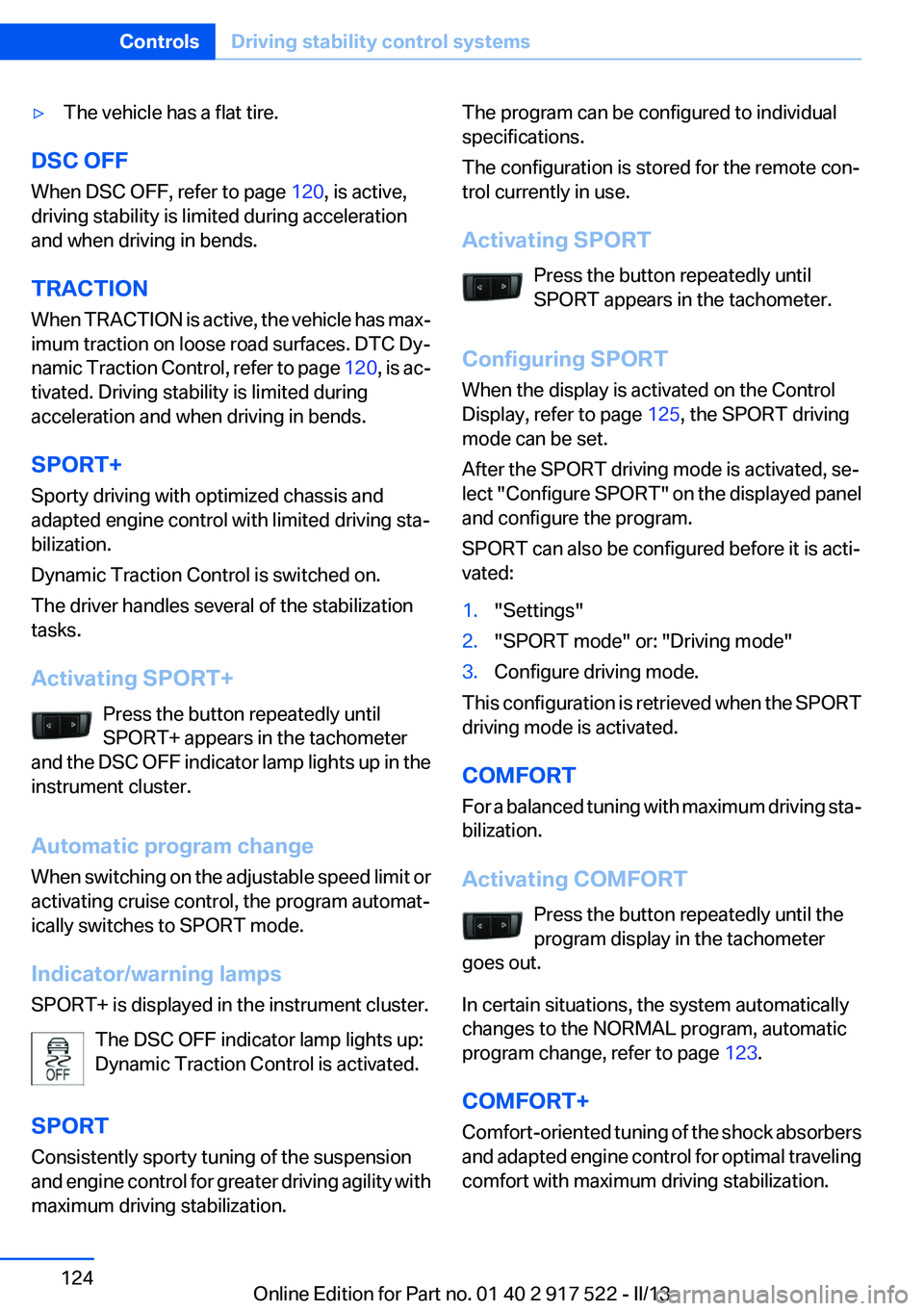
‚Ė∑The vehicle has a flat tire.
DSC OFF
When DSC OFF, refer to page 120, is active,
driving stability is limited during acceleration
and when driving in bends.
TRACTION
When TRACTION is active, the vehicle has max‚Äź
imum traction on loose road surfaces. DTC Dy‚Äź
namic Traction Control, refer to page 120, is ac‚Äź
tivated. Driving stability is limited during
acceleration and when driving in bends.
SPORT+
Sporty driving with optimized chassis and
adapted engine control with limited driving sta‚Äź
bilization.
Dynamic Traction Control is switched on.
The driver handles several of the stabilization
tasks.
Activating SPORT+ Press the button repeatedly until
SPORT+ appears in the tachometer
and the DSC OFF indicator lamp lights up in the
instrument cluster.
Automatic program change
When switching on the adjustable speed limit or
activating cruise control, the program automat‚Äź
ically switches to SPORT mode.
Indicator/warning lamps
SPORT+ is displayed in the instrument cluster.
The DSC OFF indicator lamp lights up:
Dynamic Traction Control is activated.
SPORT
Consistently sporty tuning of the suspension
and engine control for greater driving agility with
maximum driving stabilization.
The program can be configured to individual
specifications.
The configuration is stored for the remote con‚Äź
trol currently in use.
Activating SPORT Press the button repeatedly until
SPORT appears in the tachometer.
Configuring SPORT
When the display is activated on the Control
Display, refer to page 125, the SPORT driving
mode can be set.
After the SPORT driving mode is activated, se‚Äź
lect "Configure SPORT" on the displayed panel
and configure the program.
SPORT can also be configured before it is acti‚Äź
vated:1."Settings"2."SPORT mode" or: "Driving mode"3.Configure driving mode.
This configuration is retrieved when the SPORT
driving mode is activated.
COMFORT
For a balanced tuning with maximum driving sta‚Äź
bilization.
Activating COMFORT Press the button repeatedly until the
program display in the tachometer
goes out.
In certain situations, the system automatically
changes to the NORMAL program, automatic
program change, refer to page 123.
COMFORT+
Comfort-oriented tuning of the shock absorbers
and adapted engine control for optimal traveling
comfort with maximum driving stabilization.
Seite 124ControlsDriving stability control systems124
Online Edition for Part no. 01 40 2 917 522 - II/13
Page 125 of 246
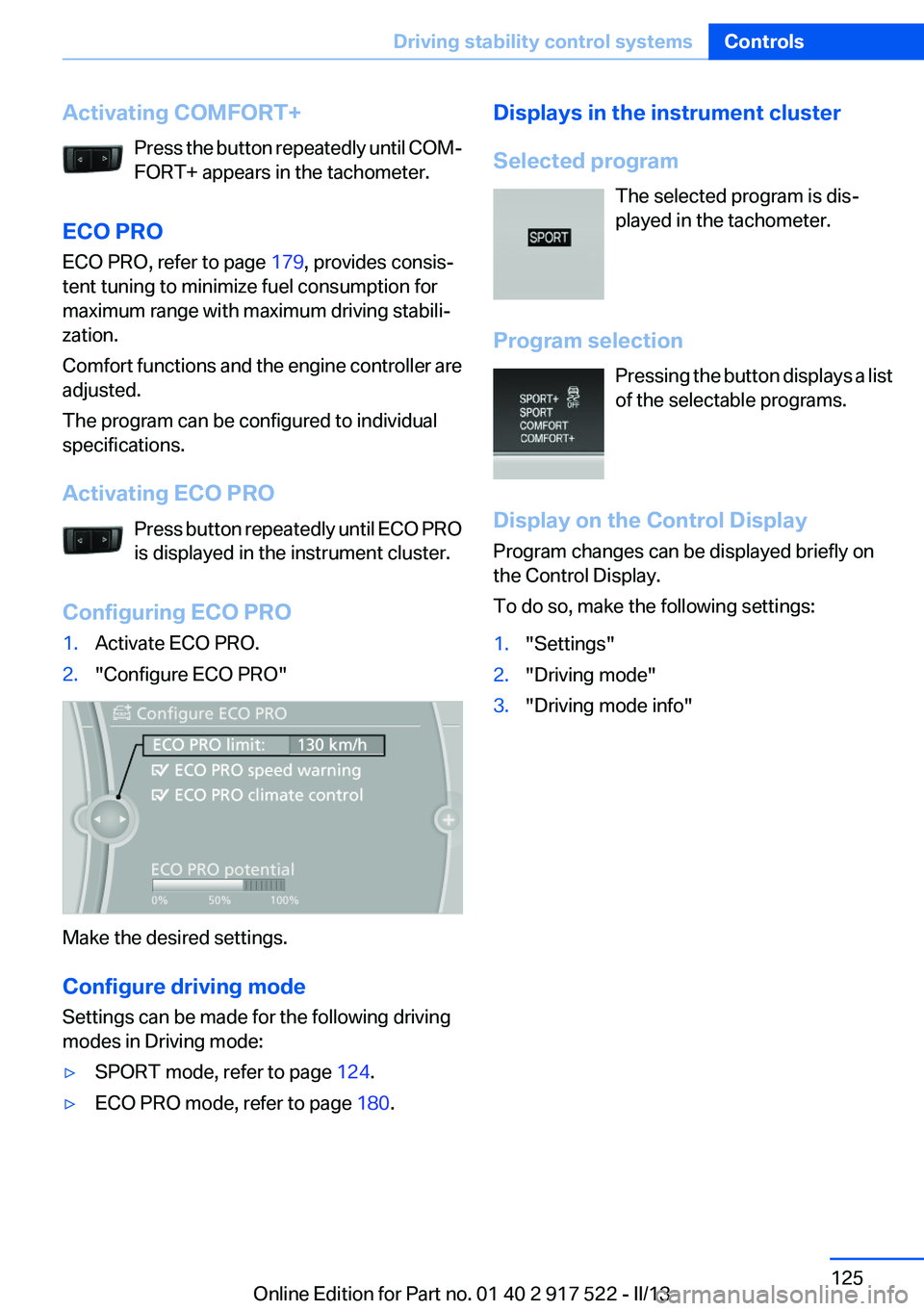
Activating COMFORT+Press the button repeatedly until COM‚Äź
FORT+ appears in the tachometer.
ECO PRO
ECO PRO, refer to page 179, provides consis‚Äź
tent tuning to minimize fuel consumption for
maximum range with maximum driving stabili‚Äź
zation.
Comfort functions and the engine controller are
adjusted.
The program can be configured to individual
specifications.
Activating ECO PRO Press button repeatedly until ECO PRO
is displayed in the instrument cluster.
Configuring ECO PRO1.Activate ECO PRO.2."Configure ECO PRO"
Make the desired settings.
Configure driving mode
Settings can be made for the following driving
modes in Driving mode:
‚Ė∑SPORT mode, refer to page 124.‚Ė∑ECO PRO mode, refer to page 180.Displays in the instrument cluster
Selected program The selected program is dis‚Äź
played in the tachometer.
Program selection Pressing the button displays a list
of the selectable programs.
Display on the Control Display
Program changes can be displayed briefly on
the Control Display.
To do so, make the following settings:1."Settings"2."Driving mode"3."Driving mode info"Seite 125Driving stability control systemsControls125
Online Edition for Part no. 01 40 2 917 522 - II/13
Page 127 of 246
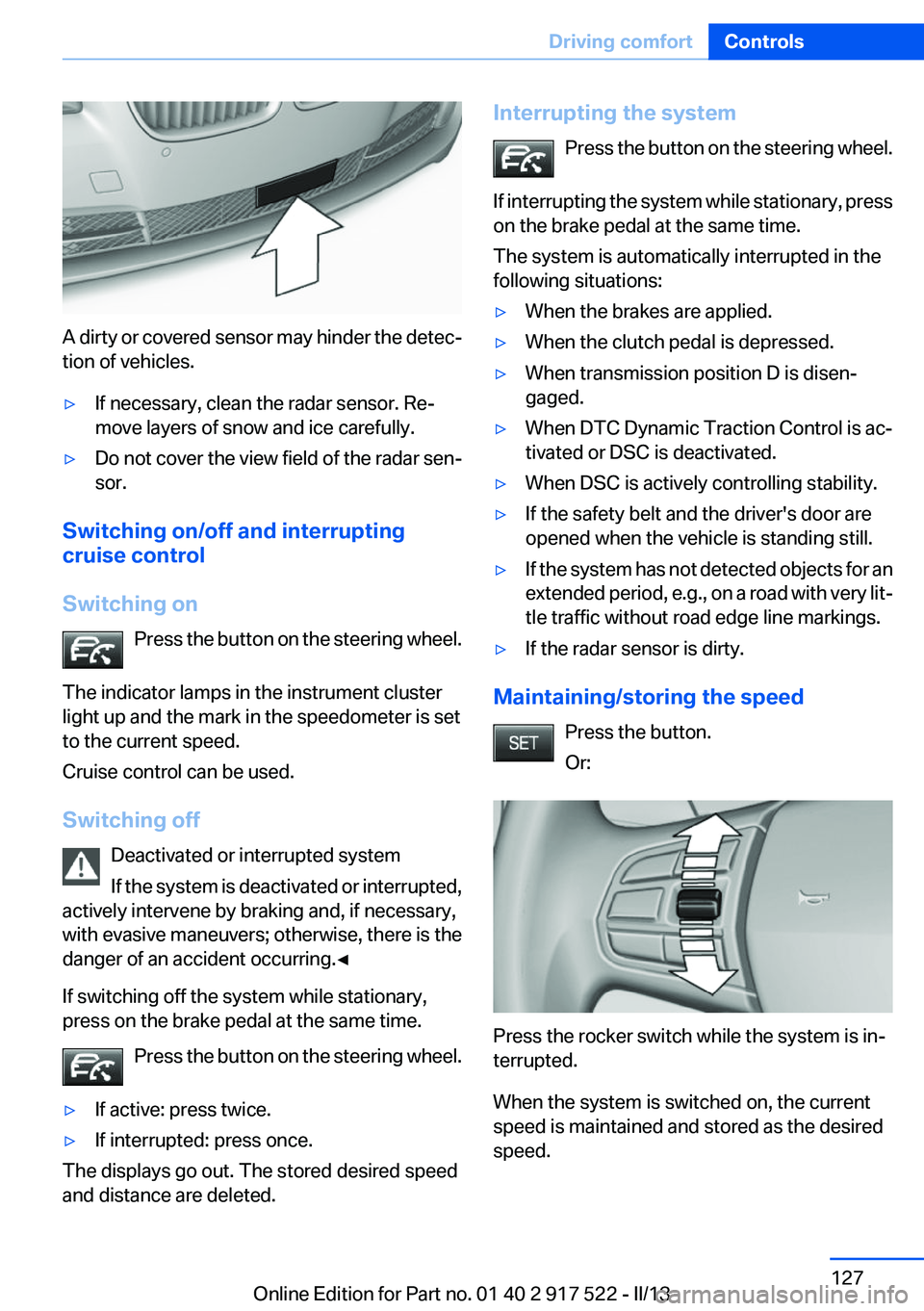
A dirty or covered sensor may hinder the detec‚Äź
tion of vehicles.
‚Ė∑If necessary, clean the radar sensor. Re‚Äź
move layers of snow and ice carefully.‚Ė∑Do not cover the view field of the radar sen‚Äź
sor.
Switching on/off and interrupting
cruise control
Switching on Press the button on the steering wheel.
The indicator lamps in the instrument cluster
light up and the mark in the speedometer is set
to the current speed.
Cruise control can be used.
Switching off Deactivated or interrupted system
If the system is deactivated or interrupted,
actively intervene by braking and, if necessary,
with evasive maneuvers; otherwise, there is the
danger of an accident occurring.‚óÄ
If switching off the system while stationary,
press on the brake pedal at the same time.
Press the button on the steering wheel.
‚Ė∑If active: press twice.‚Ė∑If interrupted: press once.
The displays go out. The stored desired speed
and distance are deleted.
Interrupting the system
Press the button on the steering wheel.
If interrupting the system while stationary, press
on the brake pedal at the same time.
The system is automatically interrupted in the
following situations:‚Ė∑When the brakes are applied.‚Ė∑When the clutch pedal is depressed.‚Ė∑When transmission position D is disen‚Äź
gaged.‚Ė∑When DTC Dynamic Traction Control is ac‚Äź
tivated or DSC is deactivated.‚Ė∑When DSC is actively controlling stability.‚Ė∑If the safety belt and the driver's door are
opened when the vehicle is standing still.‚Ė∑If the system has not detected objects for an
extended period, e.g., on a road with very lit‚Äź
tle traffic without road edge line markings.‚Ė∑If the radar sensor is dirty.
Maintaining/storing the speed
Press the button.
Or:
Press the rocker switch while the system is in‚Äź
terrupted.
When the system is switched on, the current
speed is maintained and stored as the desired
speed.
Seite 127Driving comfortControls127
Online Edition for Part no. 01 40 2 917 522 - II/13
Page 128 of 246
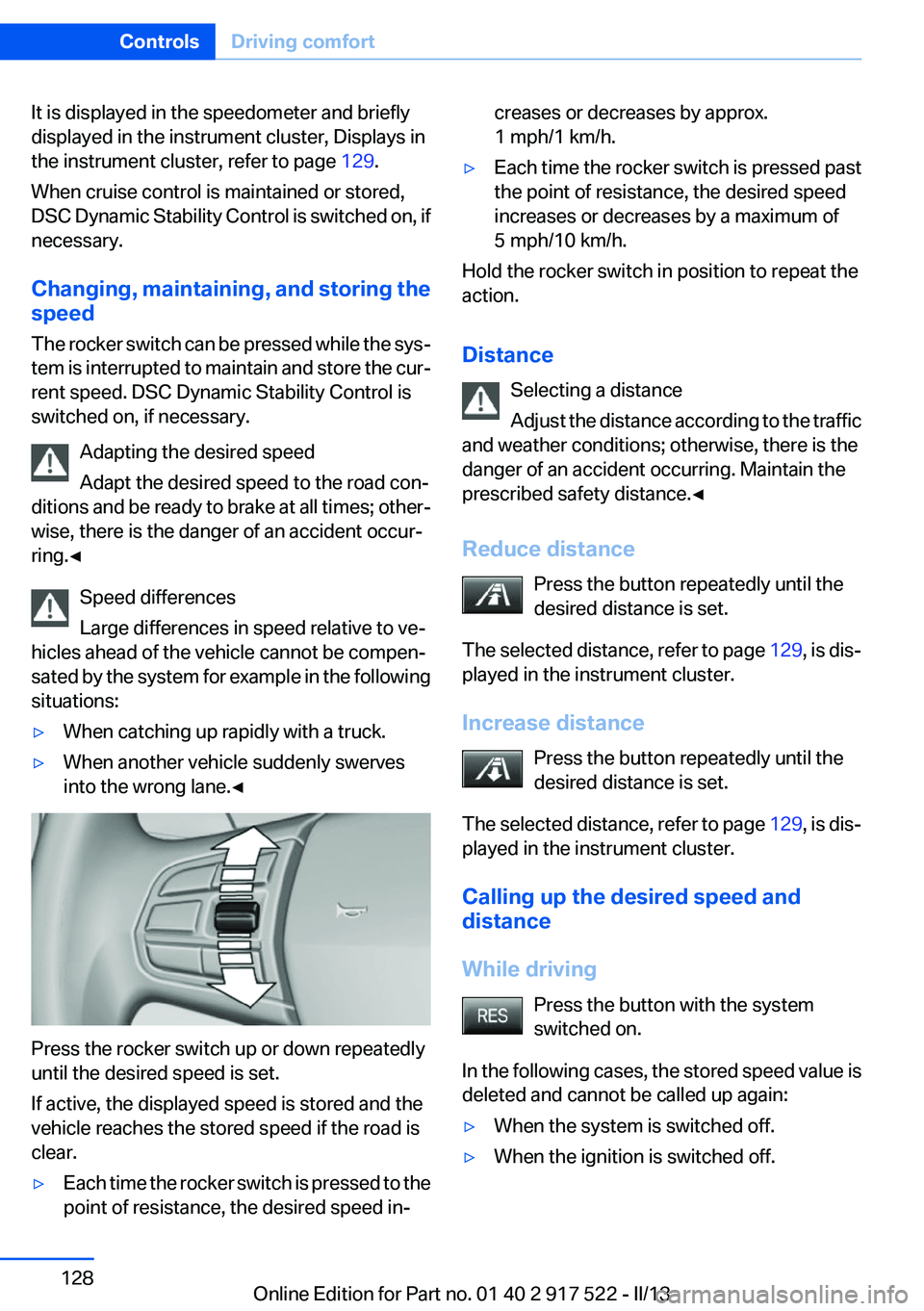
It is displayed in the speedometer and briefly
displayed in the instrument cluster, Displays in
the instrument cluster, refer to page 129.
When cruise control is maintained or stored,
DSC Dynamic Stability Control is switched on, if
necessary.
Changing, maintaining, and storing the
speed
The rocker switch can be pressed while the sys‚Äź
tem is interrupted to maintain and store the cur‚Äź
rent speed. DSC Dynamic Stability Control is
switched on, if necessary.
Adapting the desired speed
Adapt the desired speed to the road con‚Äź
ditions and be ready to brake at all times; other‚Äź
wise, there is the danger of an accident occur‚Äź
ring.‚óÄ
Speed differences
Large differences in speed relative to ve‚Äź
hicles ahead of the vehicle cannot be compen‚Äź
sated by the system for example in the following
situations:‚Ė∑When catching up rapidly with a truck.‚Ė∑When another vehicle suddenly swerves
into the wrong lane.‚óÄ
Press the rocker switch up or down repeatedly
until the desired speed is set.
If active, the displayed speed is stored and the
vehicle reaches the stored speed if the road is
clear.
‚Ė∑Each time the rocker switch is pressed to the
point of resistance, the desired speed in‚Äźcreases or decreases by approx.
1 mph/1 km/h.‚Ė∑Each time the rocker switch is pressed past
the point of resistance, the desired speed
increases or decreases by a maximum of
5 mph/10 km/h.
Hold the rocker switch in position to repeat the
action.
Distance Selecting a distance
Adjust the distance according to the traffic
and weather conditions; otherwise, there is the
danger of an accident occurring. Maintain the
prescribed safety distance.‚óÄ
Reduce distance Press the button repeatedly until the
desired distance is set.
The selected distance, refer to page 129, is dis‚Äź
played in the instrument cluster.
Increase distance Press the button repeatedly until the
desired distance is set.
The selected distance, refer to page 129, is dis‚Äź
played in the instrument cluster.
Calling up the desired speed and
distance
While driving Press the button with the system
switched on.
In the following cases, the stored speed value is
deleted and cannot be called up again:
‚Ė∑When the system is switched off.‚Ė∑When the ignition is switched off.Seite 128ControlsDriving comfort128
Online Edition for Part no. 01 40 2 917 522 - II/13